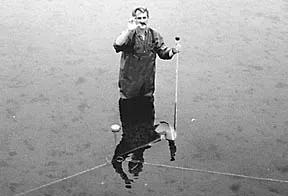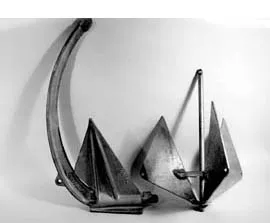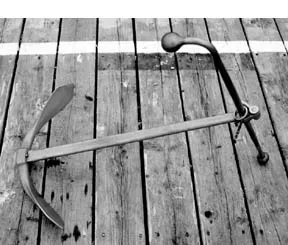When a sailor hooks his beloved boat to good, old Mother Earth, he hopes his anchor will stay put—for lunch, for a good night’s sleep, to ride out a storm or to keep the boat safe while unattended.

If done well, the anchor system should give him the cherished peace-of-mind.
However, there’s one threat that nags at him, especially when he’s not aboard.
It occurs when the wind or current sharply changes direction, a not uncommon phenomenon. That means that the well-set anchor must somehow re-align itself to the new heading. Two questions present themselves:
1. Does the anchor, without losing much of its grip, simply swivel in the mud or sand and steady up?
2. Or does the anchor pull free, flipping on its back or roll up on edge, and then re-set itself?
Seeking answers to these questions produced some dramatic results for this latest report in Practical Sailor’s continuing series on the in-the-water performance of about two dozens makes and types of anchors. Rather than one big test aimed at finding the perfect, all-purpose anchor, Practical Sailor has approached this subject carefully. Three years of work thus far has produced these published reports:
• In the February 1, 1998 issue, on which of 11 different anchors set best in sand. The top three, in order, were the Bulwagga, Spade and Bruce.
• In the January 1, 1999 issue, on which of 15 had the best holding power in sand. Top-ranked were the Spade, Bulwagga and CQR.
• In the December 1999 issue, on which of 17 anchors set and hold best in mud. Tops for setting was the Delta with six anchors tied for second; for holding power, the rank was the Barnacle, CQR and Bulwagga.
At the end of those three test sessions, the sand/mud holding power was combined and the top three anchors were the Spade, Bulwagga and CQR.
Because considerable information about how anchors behave is included in the above, it is our opinion that all of these reports, plus this new one, should be read before selecting an anchor.
Consider, for instance, this finding. While setting anchors with an electric winch and measuring the load on a dynamometer, it was noted that even moderate readings on the dynamometer immediately started down when the hauling ceased. This indicates clearly that the anchor is moving…minutely, of course, but if subjected to some tugging in a roily harbor, the minute creeping can become what is called dragging.
For even more complete coverage of this important subject, other reports have been published on anchor rode loads; swivel shackles; chain tests; rope/chain splices; sentinels; bow rollers; tests of many makes of rope anchor rodes, and a two-part report on anchor windlasses.
Makes Now Involved
Practical Sailor started out several summers ago with 11 anchors. That number did not remain constant over the ensuing tests.
An industrialist who sails had his engineering staff design the “perfect” anchor. He submitted the stainless steel prototype for testing. It was withdrawn, unnamed, after the first round. Although said to be undergoing modifications, it was not heard from again.
An anchor that simply would not set, even in sand, was dropped from subsequent tests, as was a box-like folding anchor really meant for a small boat.
Two other anchors, which were attempts to improve on established designs, proved not as good and were retrieved by their inventors–one a co-owner of one of the world’s most successful anchor manufacturers, the other a dedicated individual.
Meanwhile, other new or lesser-known anchors were submitted by their creators, including three that strongly challenge established favorites. The three are the Barnacle, the Bulwagga and the Spade.
One truth emerges: Be assured that as you read this there are some very ingenious, recusant individuals working diligently to produce an anchor that “does it all.” And it may happen, much to the benefit of all sailors.
In fact, for this phase of the testing, PS has three new anchors, which means that, as before, prior tests in sand and mud must be duplicated to obtain comparable data. The three new anchors are the Herreshoff Bronze, the Hydro-Dyne and the Seagrip.
In all cases, the size of anchor selected for the tests was determined by asking each manufacturer for the anchor they recommend for a 30′-32′ boat anchored in up to 42 knots of wind in sheltered water. (For test purposes, an anchor is considered set when it withstands a 200-lb. load; an anchor meets the above criteria when it withstands a 400-lb. load.)

The 18 anchors in this round of the tests are the 25-lb. Barnacle, the 22-lb. Bruce, the 17-lb. Bulwagga, the 22-lb. Claw, the 35-lb. CQR, the 20-lb. Danforth Deepset II, the 22-lb. Delta, the 10-lb. Fortress FX-16, the 15-lb. Hans C-Anchor, the 17-lb. Herreshoff Bronze, the 10-lb. Hydro-Dyne, the 20-lb. Nautical Engineering, the 33-lb. Seagrip, the 26-lb. Supermax Adjustable, the 26-lb. Supermax, the 16.5-lb. Spade, the 12-lb. Vetus and the 25-lb. West Marine Performance2. (Practical Sailor has tried unsuccessfully to obtain for testing a German anchor called a Bugel, about which several readers have inquired.)
The 18 anchors in hand defy categorization by type, but an attempt is made in the photos to group the lightweight, twin-fluke types, those resembling a plow and those that fit neither category. The three new anchors—the Herreshoff Bronze, the Hydro-Dyne and the Seagrip—are shown in separate photos.
The Test Procedure
Practical Sailor’s anchor tests are conducted in shallow water. Working from boats in deep water was rejected because of numerous difficulties clearly evident in the vague results obtained in many other anchor tests.
Working in shallow water facilitates very precise control of the all-important scope, but even more importantly permits careful observation by a test team member in the water of exactly what each anchor does. The hauling and measuring equipment is securely mounted ashore—on seawalls, docks or other solid bases.
The objective in this test was first to set each anchor in sand. (Previous experimentation has indicated that an anchor can be considered set when resistance reaches 200 lbs.) The rode then was relaxed.
A load then was applied to a second rode led back about 140° to 150° off the original rode’s line. The scope was held between 7:1 and 6:1.
Pulling at 90° was rejected as too likely to roll the anchors sideways. Leading back at exactly 180° also was discarded as too likely to induce the anchors to do a back flip. Most prone to doing a back flip are the twin-point lightweight anchors because of their inherently balanced distribution of weight.
As it turned out, experimenting with different angles revealed no surprises. Neither did laying an anchor with an unbalanced or hinged shank (like the Barnacle and CQR) on one edge or the other. And several experiments with the lightweight anchors produced the back flipping mentioned above.
As a load was applied to the second rode, the observer in the water noted carefully how each anchor went about realigning itself by either swiveling, rolling or flopping on its back. Of particular interest was whether the anchor broke out completely or retained some or all of its grip while rotating horizontally in the sand. Then, after the anchor, whether re-set or simply twisted to the new direction, withstood the 200-lb. test, the distance from the “old set” to the “new set” was measured.
The rodes were a 250′ continuous piece of 1/2″ Samson Super Strong nylon double braid, the hauling was done with a Harken 32 self-tailing winch, the blocks used were Lewmar and Schaefer ball-bearing models, and the load measurements were done with a calibrated Dillon dynamometer with a very handy “max” needle.
The Results
The sandy bottom appeared very regular and the anchors were under constant visual observation. Each anchor was pulled at least once, more if anything unusual was observed, such as a long distance to reset.
When the 140° resets were completed, we tried one lightweight anchor at 180°. After resetting the West Marine Performance2, the rode was reversed to 180°. When the load was applied, the anchor backed straight out of the sand until, when about half out, the shank lifted up and over and, as one would expect, the anchor flipped on its back. It refused, however, to reset, even when pulled a considerable distance. It then was noted that the flukes were not pointed down. When lifted from the water, the observer found a clam stuck in the angle between a fluke and the shank! Though unlikely, this is a possible scenario for any lightweight-type anchor. Not only shellfish can cause the flukes to jam, but also a piece of wood, rock, etc.

Once again we were reminded that seemingly minute variations in the bottom can produce magnified differences in how an anchor sets. Therefore, the chart data showing how far each anchor was pulled before setting and satisfying the 200-lb. pull requirement, should not be regarded as a precise number that will be true in all situations.
Instead of ranking the anchors, Practical Sailor placed them in four groups. The groups, from the poorest to the best, are those that broke free and failed to reset, those that reset in 3′ or more, those that reset in 6″ to 3′ and, finally, those that moved less than 6″ while swiveling into the new position.
The anchors that broke free and did not reset, but merely skipped or slid along the sandy ocean bottom, were the Hans C-Anchor and the Hydro-Dyne.
The remainder of the anchors, in the other three groups, either did not break out or did reset themselves.
The group that broke out and dragged 3 or more feet before resetting and holding 200 lbs. included the CQR, the Delta, the Nautical Engineering, the Seagrip, the Supermax and the Vetus.
Better test results—meaning that the anchors either didn’t break out completely or that they reset themselves very quickly in between 6″ and 3’—were the Barnacle, the Claw, the Bulwagga, the Danforth Deepset, the Herreshoff Bronze and the West Marine Performance2.
In the best test group, those that did not break out and moved very little (from not measurable to no more than 6″), were the Bruce, the Fortress FX-16, the Supermax (with the adjustable shank) and the Spade.
Would the same results prevail in mud or a gravel bottom? The answers must await other rounds of this continuing series of tests.
The Bottom Line
Although minute differences might not seem important when considering an anchor’s ability to withstand a pull in a new direction, those that did not break out surely are preferable to those that broke out, moved some distance and re-set. An anchor that must reset itself represents a danger—partly because the bottom might change, debris can be picked or the rode can foul the anchor.
The Herreshoff Bronze was a surprise. This very handsome new version of a very traditional anchor set quickly, in 2′, and broke out and reset itself in 3′. In sand, its weak point is holding. It dragged at 300 lbs., 100 lbs. short of the 400-lb. requirement. It essentially is a rock anchor.
The best lightweight anchor was the Fortress, which simply swiveled in a horizontal plane around the shank and took up its new alignment. In the setting and holding tests, the Fortress ranked near the middle.
The performance of the Bruce was no surprise, considering it ranked near the top for setting (in either sand or mud). Because of its mediocre holding power, Practical Sailor recommends that if a Bruce is selected, a larger size should be in order. The same is true of the Supermax.
The Bulwagga and the Spade performed in a manner that did nothing but enhance the showings they made in the sand/mud setting and holding phases of the PS tests.
Also With This Article
Click here to view Reset Results In Sand.
Click here to view Value Guide: Anchors.
Contacts- Barnacle, 1020 24th Ave. E., Ellenton, FL 34222; 800/295-2766. Bruce, Bruce/Imtra, 30 Barnet Blvd., New Bedford, MA 02745; 508/995-7000. Bulwagga, NoTECO, Inc., Box 533, White Church Rd., Crown Point, NY 12928; 888/674-4465. CQR, Delta & Claw, Lewmar, 351 New Whitfield St., Guilford, CT 06437; 203/458-6300. Danforth, Rule Industries, Cape Ann Industrial Park, Gloucester, MA 01930; 978/281-0440. Fortress, 1386 W. McNab, Ft. Lauderdale, FL 33309; 800/825-6289. Hans C-Anchor, Box 66756, St. Petersburg, FL 33736; 800/728-4645. Herreshoff Bronze, J.M. Reineck & Son, 9 Willow St., Hull, MA 02045-1121; 781-925-3312. Hydro-Dyne, 1424 Old U.S. 264, Zebulon, NC 27597; 919/404-0409. Nautical Engineering, 700 Doheny Dr., Northville, MI 48167; 248/349-1034. Seagrip, 511 Sunset Beach, Richmond Hill, Ontario, Canada, L4E-3J7; 905/773-4002. Spade, B.P. 103-40, rue lbn Safouane, 2036 La Soukra, Tunisia; 216/1 869 099, fax 216/1 865 250. Supermax, Box 2120, 243 John R. Junkin Dr., Natchez, MS 39121-2120; 800/824-0355. Vetus, Vetus Den Ouden Inc., Box 8712, Baltimore, MD 21240; 410/712-0740. West Performance, West Marine, 500 Westridge, Watsonville, CA 95077-5050; 800/538-0775.

































